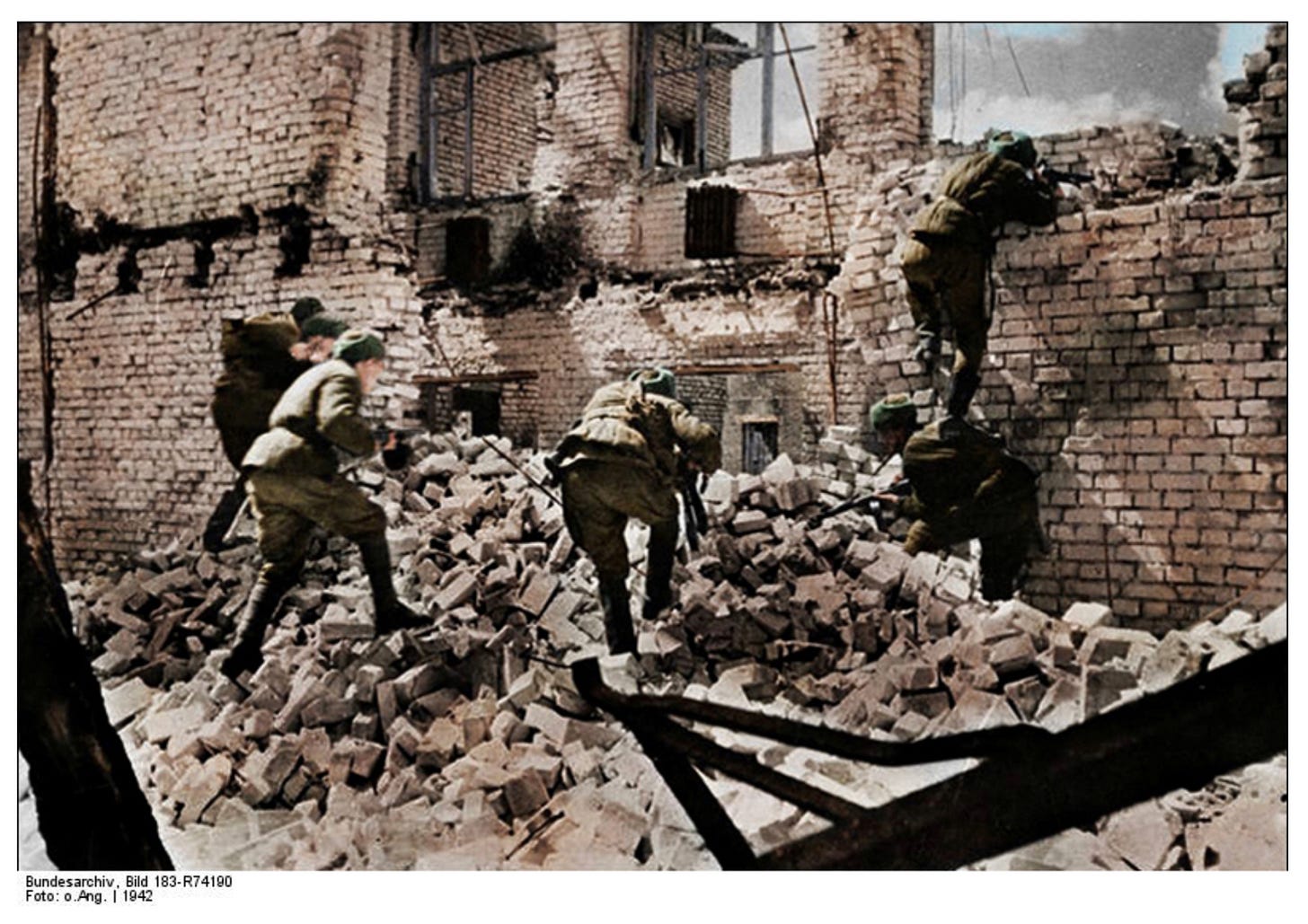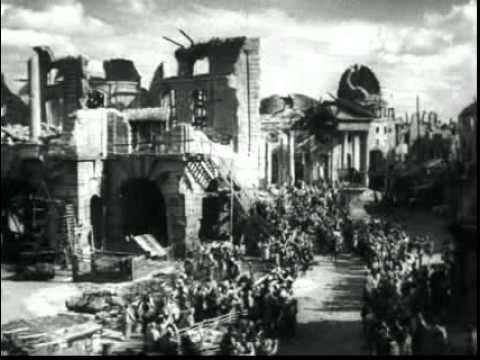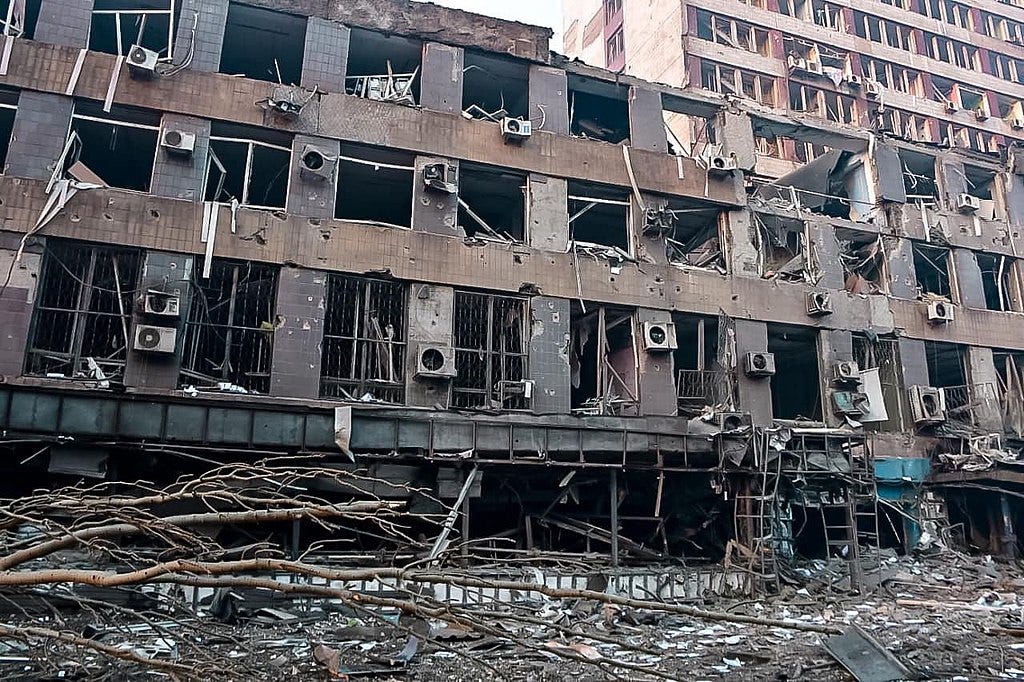I came across some old notes, from a talk by the military historian Anthony Beevor in 2015, and I think that when I took them I’d hoped they might be historical. But the Ukraine war has dragged them sharply into the present. The anniversary of that war seems a good moment to share those notes, and my reflections on them now.
Listening to Anthony Beevor on the subject of war over the last 75 years, it became clear that his real subject was the role of the city in modern warfare, or even the rise of the city in war.
He started with the observation that although the Napoleonic war covered much of the land mass of Europe, there was hardly any urban fighting.
One reason: commanders knew how quickly discipline broke down when troops found alcohol, and it was much easier for them to desert. Similarly, World War 1 created its own military landscape.
Street by street
This all changed with World War II, although—like other aspects of World War II—it was presaged by theSpanish Civil War. In 1940, with Paris about to fall, Churchill urged Weygand and Petain to fight the Germans street by street. In Beevor’s account, they were appalled.
Weygand, a career officer, had been the French Ambassador to Spain during the civil war, and had seen anarchists take control of Barcelona during the urban fighting there. Beevor didn’t mention it, but it’s possible that his view was also shaped by the history of the Paris Commune, 70 years earlier.
And so it fell to Stalingrad to be the example of urban fighting. Hitler’s ambition to capture Stalingrad came partly from the prestige of capturing the city that Stalin had named for himself, by Beevor’s account, and partly to distract from the Wehrmacht’s failure to seize the oilfields to the south.

(Soviet soldiers at the battle for Stalingrad, via snl.no. CC BY SA 3.0)
Defensive terrain
Neither side was experienced in such fighting. Indeed, the Luftwaffe’s success in bombing much of the city created ideal defensive terrain. The U.S. Army got their first taste of urban warfare in Aachen, on the German border, after Hitler ordered that the city was to be held at all costs.
Artillery turned out to be the best form of attack, in the same way, perhaps that the British had pounded the centre of Dublin during the 1916 uprising and also insisted that the Irish Free State shell the IRA when they occupied the Four Courts.
Fast forward, then, to the Second Iraq War and the rise of ISL a decade afterwards. Before that war there was something of a media frenzy about he possibility that the attack on Baghdad might look something like Stalingrad. It didn’t happen. Saddam’s wide straight avenues were good territory for armoured regiments, targeted bombing left most of the city intact, and Iraqi soldiers melted away in the face of the Coalition’s overwhelming firepower.
‘Battleground Metropolis’
All of this history, coupled with the relentless growth of cities in the Global South, led some military strategists to conclude that in future all warfare would be urban warfare.
National Interest ran an article around the same time as Beevor gave his talk setting out this argument. In case there was any doubt, it was headlined, ‘Battleground Metropolis: The Future of Urban Warfare’:
The rise of megacities , urban areas with populations of 10 million or more, significantly complicates fighting in urban terrain. While some of the largest cities in the world (projected in 2030) are relatively secure—Tokyo, Shanghai and Beijing—others, like New Delhi, Karachi and Lagos, will likely be centers of unrest.
You can draw your own conclusions about the kinds of assumptions that sit behind this sweeping urban classification, but for National Interest the implications were clear:
As cities grow to megacity status, we should expect this urbanization to strain urban municipal infrastructure and create divisions in society , all of which will lead to greater socio-economic and socio-political friction, thereby generating a greater chance of conflict… Poor governance in great urban areas will become a fertile breeding ground for organized crime, terrorism and other forms of violence. They will threaten the interests of locals, the United States, its partners and allies
‘The Shape of Things’
The National Interest article pointed towards lighter, but more lethal, weapons, much more ‘smart’ tech-driven capability, and more specialist troops. Back at the talk, there was some discussion from the audience as to whether doctrine and equipment would move towards lighter vehicles, or whether this idea of future urban warfare was already out of date.
Beevor, back then, probably wouldn’t have been aware of Assad’s attacks on rebel city areas, backed by Russian artillery, but all of this discussion has come into a sharp and depressing focus because of the war in Ukraine.
The attacks on cities there have been more reminiscent of World War II, intended to destroy urban infrastructure, worsen their living conditions, and wreck their morale. The Russians have been using artillery, missiles, and drones to do this, rather than bombers, but the principle goes back to the early theory of war from the air: that the bomber will always get through. HG Wells’ story The Shape of Things to Come, made into a film in the 1930s, used this as a starting point, and the British Prime Minister Stanley Baldwin used it in a speech in 1932.

(Still from ‘Things to Come’ (1936)
Futures fads
The last part of this hypothesis has turned out to be wrong, whenever it has been tested, and it seems that it’s turning out to be wrong in Ukraine as well. Indeed, it also looks as if heavier vehicles not lighter ones, fighting in fairly conventional ways, may be decisive. In Ukraine, Russia’s aerial attacks on cities, civilians, and civilian infrastructure look like a substitute for an effective military capacity rather than a new doctrine.
I think I conclude a couple of things from this. The first is that civilians will continue to be targets for military actions, and that will continue to come from the air. But no-one orchestrating these attacks should expect them to destroy civilian morale. Even in the extreme case of Syria they were used mostly as a form of collective punishment for those who had dared oppose Assad’s regime.
The second is that military analysts are subject to the same futures fads as everyone else. There are cities in Latin America that are riven with violence, often associated with the global cocaine business, as Ian Christie noted to me. But no matter how poor the urban governance, no matter how unruly your cities, political leaders aren’t going to call in America or its allies, as the National Interest article suggests. Because nothing says ‘I’ve lost control of my sovereign territory’ quite like asking foreign troops to help with your governance problems.
Markers of failure
One of the things we also learnt from wars, from Algiers to northern Ireland, and more recent conflicts elsewhere, is that troops are not well-placed in such situations. In an age of asymmetric warfare they become targets for all kinds of improvised devices. You end up with cycles of reprisals that make the prospects for peace more distant.
Obviously the kinds of war being fought in Ukraine and these “governance” conflicts are completely different. One is an old-fashioned ‘back to the future’ kinetic war based on combined operations where the attacks on cities have little strategic value. Such attacks are somewhere between a propaganda sideshow and a form of punishment for resistance.

(War damage in Mariupol, 12 March 2022, Ministry of Internal Affairs, Ukraine. Mvs.gov.ua. CC BY 4.0)
The others are usually a marker of a failure to resolve real political and economic conflicts by other means. They speak to a need identified in some work I did with Chatham House last year:
Transnational institutions for managing conflict resolution and responding to kinetic warfare are well established… (However) there is an opportunity to create new institutions or modify existing ones with a formal objective of pre-emptive monitoring and management of security risk, with the purpose of maintaining peace rather than having to intervene after conflict has broken out. These institutions should add a security perspective to the analysis of climate change impacts and the criticality of natural resources, identify potential trigger points for disputes, and seek to defuse them.
——
A version of this article is also published on my Just Two Things Newsletter.
